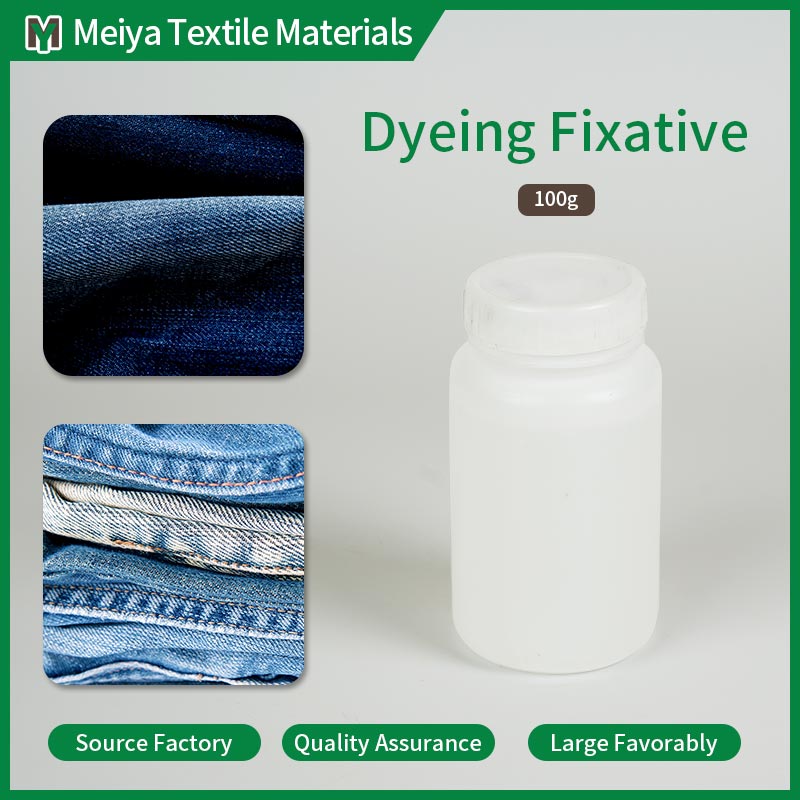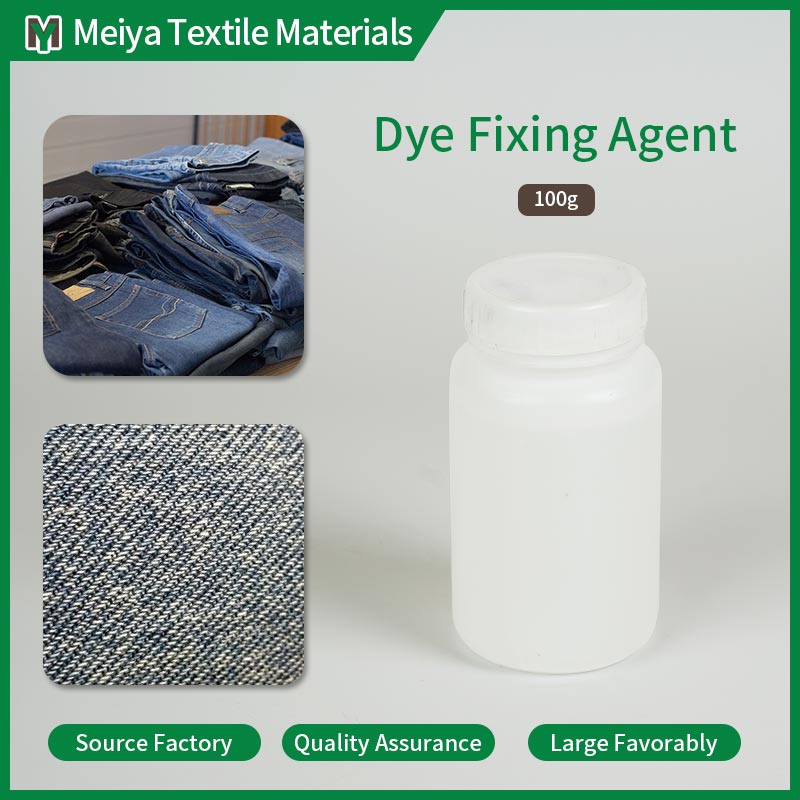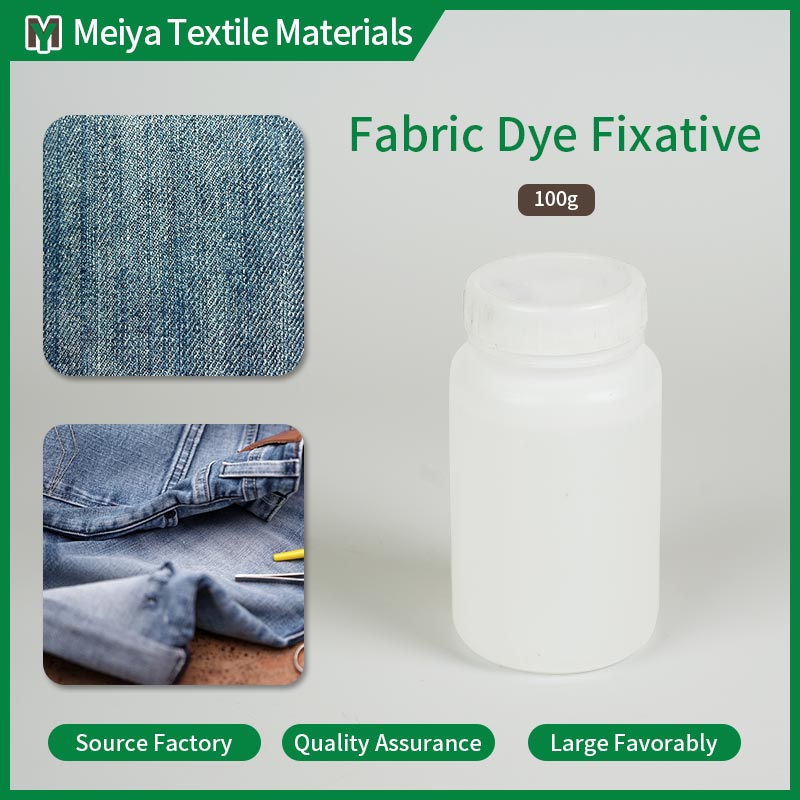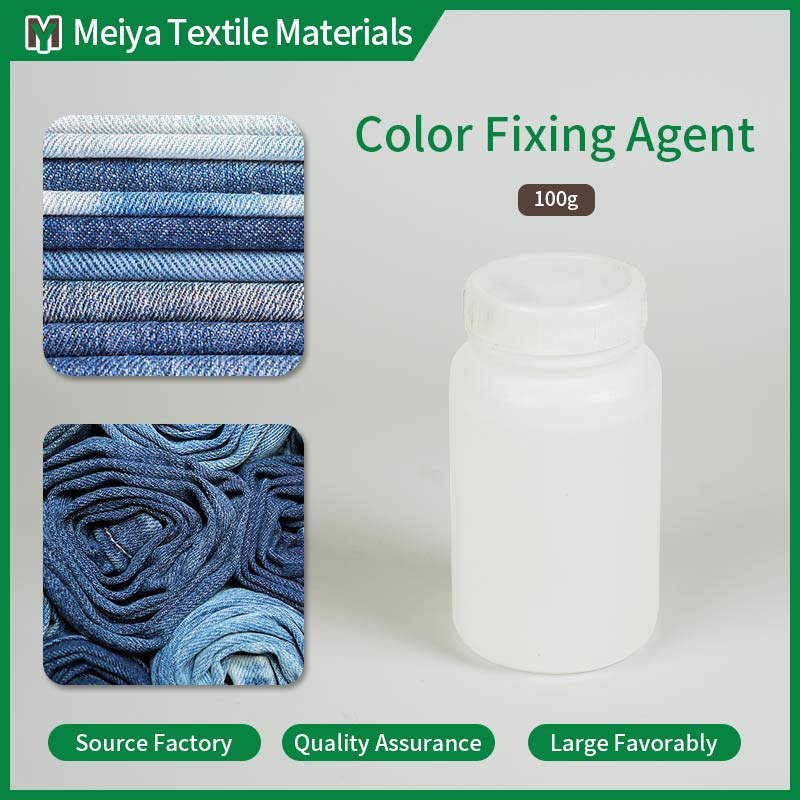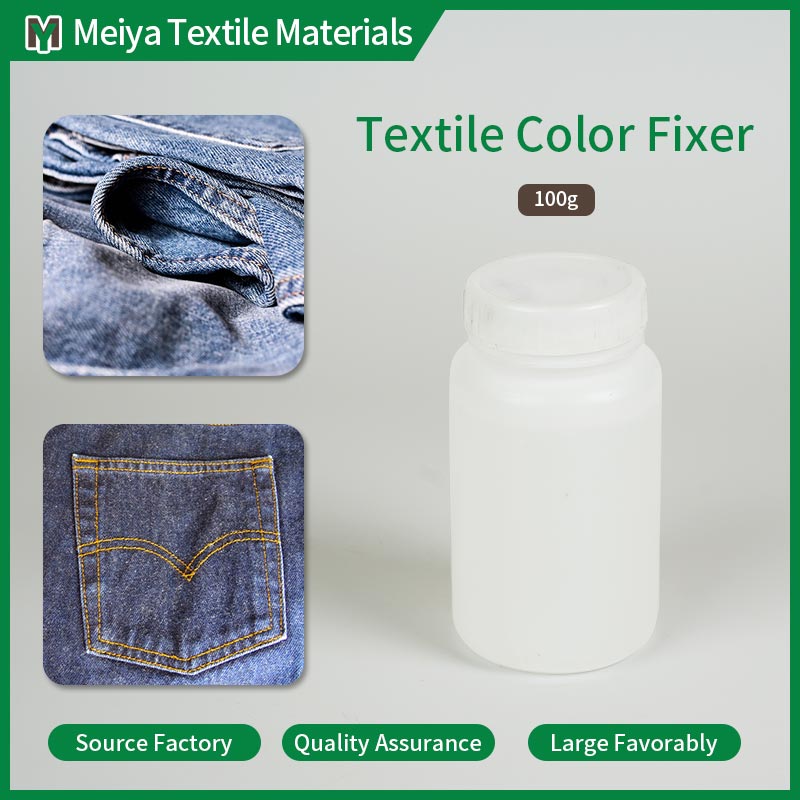Practical Textile Color Fixer
Please click the button below to contact us.
Introduction:Textile Color Fixer is a chemical additive used to enhance the color fastness of textiles. It is usually presented in white bottles, each bottle has a capacity of 100g. In the textile printing and dyeing industry, newly dyed textiles often have problems such as easy color shedding and fading.
Product Description
Textile Color Fixer is a chemical additive used to enhance the color fastness of textiles. It is usually presented in white bottles, each bottle has a capacity of 100g. In the textile printing and dyeing industry, newly dyed textiles often have problems such as easy color shedding and fading. textile color fixer can react with dyes and fibers to form a protective film on the surface of textiles or make the combination between dyes and fibers more firm, thereby improving the color fastness of textiles and making the colors more durable and brighter.
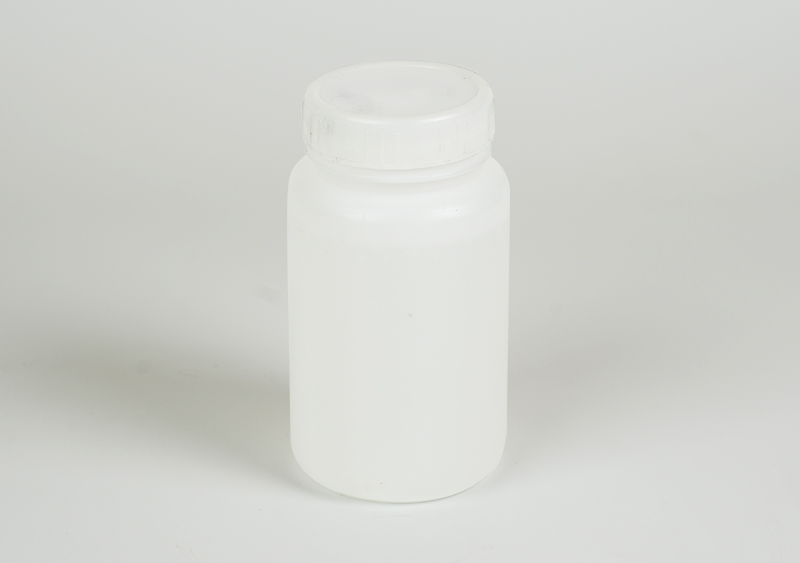
Textile Color Fixer Features:
Significantly improve color fastness: The Textile Color Fixer performs well in improving the color fastness of textiles. After professional testing, the dry friction color fastness of textiles can be improved by 1-2 levels, and the wet friction color fastness can be improved by 0.5-1.5 levels. Taking standard test conditions as an example, the wet friction color fastness of untreated textiles may only be 2-3 levels, but after being treated with a fixing agent, it can reach 3-4.5 levels. The principle behind this is that the fixing agent forms a dense protective film on the fiber surface, just like putting on a layer of "protective clothing" for the dye, effectively preventing the dye from falling off during friction.
Wide applicability: Its scope of application is extremely wide, covering almost all common textiles made of various fiber materials, including cotton, linen, silk, wool and their blended fabrics. It has a good fixing effect for different types of dyes, such as reactive dyes, direct dyes, sulfur dyes, etc. In the laboratory tests of various fiber materials and dye combinations, no matter which combination, the color fastness of the color fixer has been significantly improved, which provides great convenience for the textile printing and dyeing industry and greatly broadens its application range.
Environmental protection and low pollution: Today, with the increasing awareness of environmental protection, the color fixer meets strict environmental protection standards. It does not contain harmful heavy metals and formaldehyde and other substances that are harmful to the human body and the environment. During production and use, its chemical oxygen demand (COD) emissions are low, and the pollution to water resources is minimal. After professional testing, its COD emission value is far lower than the industry standard limit, which not only meets the current green and environmentally friendly production requirements, but also helps enterprises achieve sustainable development.
Strong washability: Textiles treated with color fixers have excellent washability. Under the conditions of simulated home washing, after 50 washes, the color change rate is 30% - 50% lower than that of untreated samples. This is because the color fixer forms a stable chemical bond with the dye and fiber, like a "firm lock", which locks the dye tightly on the fiber, making it difficult for the dye to fall off during washing.
No influence on the feel and color: An excellent color fixer should not only improve the color fastness, but also not have a significant effect on the feel and color of the textile. This color fixer performs well in this regard. It can maintain the original soft feel and bright color of the textile while ensuring color fastness. After professional evaluation, the change rate of the softness of the treated textile is less than 10%, and the ΔE value of the color change is less than 2 (in the CIELAB color space), ensuring the high quality of the textile.
Good stability: The color fixer has good chemical stability, and its color fixation effect remains basically unchanged under different pH values (3 - 10) and temperatures (20 - 80℃). In the complex printing and dyeing process environment, whether it is a change in pH or a fluctuation in temperature, it can play a stable role, ensure the consistency of dyeing quality, and provide reliable guarantee for printing and dyeing production.
Good compatibility: In the process of textile printing and dyeing, a variety of auxiliaries are often required. This color fixer has good compatibility with other textile printing and dyeing auxiliaries such as softeners and antistatic agents. It can be used with other auxiliaries at the same time without chemical reaction or affecting each other's performance, which facilitates the integration and optimization of printing and dyeing processes and improves production efficiency.
Rapid color fixation: In today's pursuit of efficient production, the rapid color fixation characteristics of this color fixer are particularly important. Under normal temperature conditions, the color fixation reaction can be basically completed within 30-60 minutes. Compared with some traditional color fixers that require long-term high-temperature treatment, it greatly reduces energy consumption and production cycle, reduces production costs, and improves the economic benefits of enterprises.
Where can we use Textile Color Fixer?
Garment manufacturing industry: In the garment manufacturing industry, the role of Textile Color Fixer is crucial. Whether it is a simple cotton T-shirt, an elegant silk shirt or a high-end wool coat, the use of a color fixer can significantly improve the color fastness of clothing. For colorful and fashionable clothing, the color fixer is like their "preservative", which can ensure that the color of the clothing remains bright as before during multiple washings and wearings, improve the overall quality and market competitiveness of the clothing, and meet consumers' high requirements for clothing quality.
Home textile industry: Home textile products such as bed sheets, quilt covers, curtains, etc. are items that people often touch and use in their daily lives. These products need to be washed frequently and have a long service life, so the requirements for color fastness are also very high. The application of textile color fixers can ensure that these products do not fade or cross-color during use and washing, and maintain good appearance and quality. For example, after the dark bed sheets are fixed, the color remains deep and bright even after multiple washings, and will not appear white or fade, creating a warm and comfortable home environment for consumers.
Automotive interior: Textiles such as seat fabrics and ceiling fabrics in automotive interiors need to be not only beautiful but also durable. These textiles are affected by friction, light, and cleaning in daily use. The use of textile color fixers can improve their color stability and extend their service life. At the same time, the beauty of the interior environment is maintained to provide a better visual experience for drivers and passengers. For example, after the color fixation treatment of car seat fabrics, the color is not easy to fade under long-term use and sunlight, and it always maintains a good visual effect, improving the overall quality of the car.
Toy manufacturing industry: The textile part of children's toys such as plush toys and cloth toys is closely related to the health and safety of children. The use of textile color fixers can not only improve the color fastness of toys and prevent children from accidentally eating the color during play, but also meet environmental protection requirements and ensure the health and safety of children. Toys that have been treated with color fixation still have bright colors after repeated washing and rubbing, which increases the use value and attractiveness of the toys and allows children to enjoy the fun of playing.
Hotel supplies industry: Hotel bedding, towels, bathrobes and other textiles are used frequently and need to be washed frequently. The color fastness of these textiles directly affects the overall image and service quality of the hotel. The use of textile color fixers can ensure that these textiles do not fade during a large number of washings and maintain white or bright colors. For example, after the hotel's white towels are treated with color fixation, they can still remain white and new even after multiple washings, leaving a good impression on guests and improving guest satisfaction.
Industrial fabric field: In some industrial fields, industrial fabrics such as filter cloths and conveyor belts need to have good color fastness and durability. These industrial fabrics may be exposed to various chemicals, friction and pulling during work. The use of textile color fixers can improve their color stability, making their colors less likely to fade in harsh working environments, while enhancing the overall performance of the fabrics and ensuring the normal progress of industrial production.
Sporting goods industry: Textiles for sporting goods such as sportswear and sports towels are affected by sweat, friction and other factors during exercise. If the color is easy to fall off, it will not only affect the appearance, but also the mood and performance of the athletes. The use of textile color fixers can improve the color fastness of these products, so that athletes do not have to worry about color fading during exercise. For example, after the color fixing treatment, sports T-shirts can maintain bright colors and good appearance even when sweating a lot and exercising frequently, allowing athletes to devote themselves to sports.
Crafts production: In the production process of textile crafts, such as embroidery, printing and dyeing crafts, the brightness and fastness of colors are important indicators to measure their artistic value. Textile color fixers can help handicrafts not fade during preservation and display, and maintain their unique artistic charm. For example, after a beautiful embroidery work is treated with color fixing, it can maintain the bright and delicate colors for a long time, becoming a work of art with collection value, inheriting and promoting culture and art.
Military supplies: Textiles for military supplies such as military clothing and tents need to have high durability and color stability. In harsh military environments, such as battlefields and field training, these textiles may be affected by various extreme conditions. The use of textile color fixers can improve their color fastness, so that their colors remain stable when they are exposed to natural environments such as sunlight, wind and rain for a long time, while enhancing the overall performance of textiles, ensuring the smooth progress of military operations, and playing their important functions such as camouflage and identification.
Medical textiles: Medical textiles such as bed sheets, patient gowns, and surgical dressings used in hospitals need to be frequently cleaned and disinfected. The color fastness of these textiles is not only related to their neat appearance, but also closely related to the hygiene and safety of the medical environment. The use of textile color fixatives can ensure that these products do not fade during multiple cleaning and disinfection processes, while meeting the hygiene and safety requirements of the medical environment. For example, after the surgical dressing has been fixed, the color will not fade under strict disinfection conditions, ensuring a clear view and hygiene standards during the operation, providing strong support for medical work.
Textile Color Fixer Maintenance:
Sealed storage: Unused textile color fixatives should be strictly sealed for storage. This is because moisture and impurities in the air may enter the bottle and react chemically with the color fixative, thus affecting its performance. When storing, make sure the bottle cap is tightened and store it in a dry, cool, ventilated place away from direct sunlight. Generally speaking, the color fixative can be valid for 1-2 years if it is sealed and stored in a dry environment below 25°C. If it is not stored properly, it may cause the color fixative to expire prematurely, affecting the use effect.
Avoid mixed storage: It is very necessary to store textile color fixatives separately from other chemicals. In particular, it is necessary to avoid contact with strong acids, strong alkalis, oxidants and other substances, because these substances may react chemically with the color fixative, causing the color fixative to deteriorate or fail. In the warehouse, a special storage area should be set up and clearly marked to prevent misplacement and misuse. At the same time, the separate storage of chemicals of different properties is also conducive to safety management and reduces the risk of safety accidents such as fire and explosion.
Regular inspection: Regular inspection of the storage status of the color fixative is an important part of ensuring its quality. Observe whether there are precipitation, stratification, discoloration and other phenomena. If any abnormality is found, stop using it immediately and contact the supplier or professional for testing and treatment. It is recommended to conduct a comprehensive inspection every 3-6 months. During the inspection, carefully check whether the appearance and packaging of the color fixer are intact. Timely detection of problems can avoid the use of deteriorated color fixers and ensure production quality.
Prevent freezing: In low temperature environments, textile color fixers may freeze, which will seriously affect their use effect. If the storage environment temperature may be lower than 0℃, effective warming measures should be taken, such as wrapping with insulation materials or storing in a warm room. Once the color fixer is frozen, it should be thawed naturally at room temperature and fully stirred before use. However, it should be noted that the performance of the color fixer after thawing may decline, and a small sample test is required to ensure that it still meets production requirements.
Correct use: When taking the color fixer, clean and dry tools should be used to avoid bringing in moisture and impurities. Because moisture and impurities may affect the purity and performance of the color fixer, and thus affect its color fixation effect. After use, the bottle mouth should be sealed in time to prevent volatilization and contamination. During the operation, safety regulations should be strictly followed, and protective equipment such as gloves and goggles should be worn to prevent the color fixer from contacting the skin and eyes. If contact is made accidentally, rinse immediately with plenty of clean water and seek medical attention in time.
Control storage temperature: Try to store the color fixer in an environment with relatively stable temperature to avoid excessive temperature fluctuations. Generally speaking, the storage temperature should be controlled between 10-30℃. Too high temperature may cause the effective ingredients of the color fixer to decompose and reduce its color fixation performance; too low temperature may cause freezing and performance changes. A thermometer can be used to monitor the storage environment in real time to ensure that the temperature is within the appropriate range.
Avoid vibration: Avoid severe vibration during transportation and storage. Although slight vibration may not have a significant effect on the performance of the color fixer, severe vibration may cause the internal structure of the color fixer to be destroyed, causing problems such as stratification or precipitation, affecting its uniformity and use effect. When transporting, handle with care and use appropriate handling tools to ensure the safety of the color fixer.
Record and save information: Establishing a storage file for the color fixer is a very important management task. Recording its production date, storage date, storage location, inspection status and other information can facilitate the management and tracking of the use of color fixers. Through these records, expired or deteriorated color fixers can be handled in time to avoid misuse. At the same time, it is also helpful to trace and analyze the source when problems arise, find out the causes of the problems, and take corresponding improvement measures.
Training operators: Professional training for operators who use and keep color fixers is essential. The training content should include aspects such as the characteristics, storage methods and safety precautions of color fixers. Operators should be familiar with the use specifications and emergency treatment measures of color fixers to ensure that they can use and keep color fixers correctly during operation. Through training, the professional quality and safety awareness of operators can be improved to avoid quality problems or safety accidents caused by improper operation.
Waste disposal: For expired or deteriorated textile color fixers, they should be disposed of in accordance with relevant environmental protection regulations. They cannot be dumped or discharged at will to avoid pollution to the environment. You can contact a professional waste disposal company to harmlessly treat the color fixer to ensure compliance with environmental protection requirements. In the process of waste treatment, good records should be kept for supervision and traceability. Proper treatment of waste fixing agents is not only a reflection of corporate social responsibility, but also helps protect the ecological environment.
Textile Color Fixer FAQs:
1. What is Textile Color Fixer, and how does it work in practice?
Textile Color Fixer is a dye fixing agent which is used to further improvement of the colours applied to denim fabrics. It lies in the fact that the dye molecules are chemically bonded with the fabric fibers. This ensures that the amount of color wash off during laundry is minimized enabling the denim to keep its brash look.
2. Is Textile Color Fixer safe to use in denim manufacturing?
Our Heat Transfers are built to sell internationally and have to comply to internationally accepted health safety standards. Its preparation is devoid of danger hence providing the necessary security to the workers during the production stage and also the users of the end products.
3. How can I use Textile Color Fixer in the process of denim manufacturing?
Textile Color Fixer may be applied at the various steps of denim manufacturing such as dyeing, pre-washing, finishing among others. Trial runs should be carried out in order to establish tailor made conditions for the method and concentration of tools application.
4. In what ways is the product favorable to sustainability?
The application of our Textile Color Fixer comes in handy because it lowers the chances of going through the whole dyeing operation which further leads to water contamination from the dyes. The further helps to reduce wastage through the ensured effective color retention and thus is beneficial for production processes of sustainable denim as it puts into consideration environmentally friendly practices.
5. Can Textile Color Fixer be used with other treatments?
Yes, Textile Color Fixer can be effectively combined with other finishing agents, such as softeners and waterproofing agents. However, it is essential to test these combinations to ensure compatibility and desired results in the final product.

